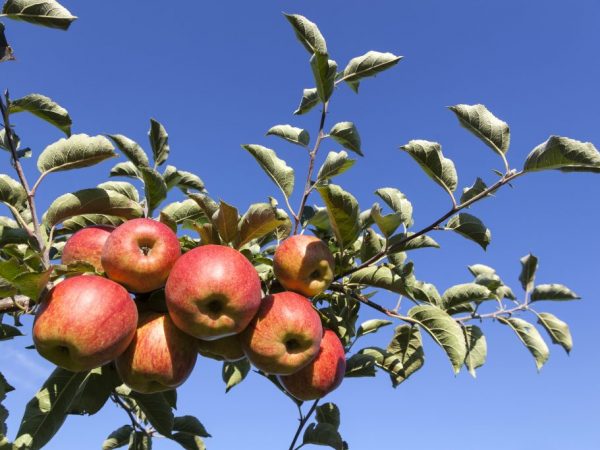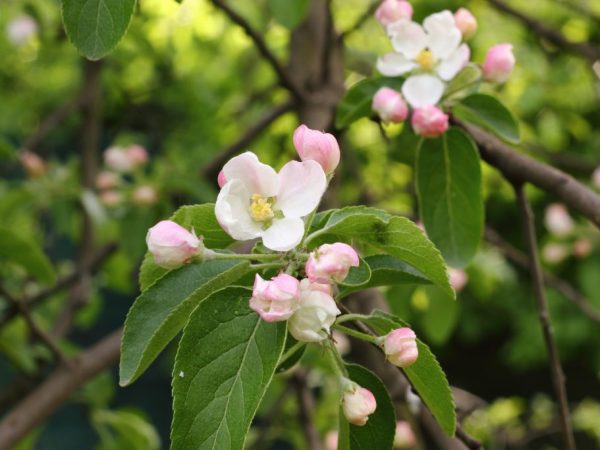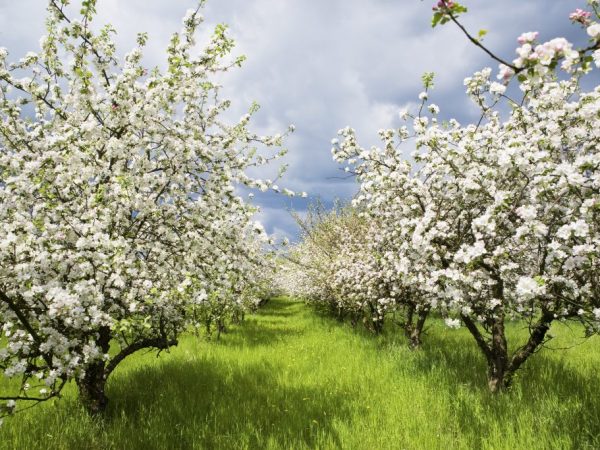Apple variety Pink filling
Apple-tree Pink filling is a national favorite that grows in many gardens. Unfortunately, nothing is known about the breeders of this variety, as well as about the exact time of breeding. The apple tree has existed for so long that its selection is called "folk". This beauty with elegant early apples will certainly decorate your garden and delight the whole family.

Apple variety Pink filling
general characteristics
The apple tree belongs to medium-sized trees and reaches a height of 2-3 m. Its distinctive feature is the pyramidal crown, which thickens and becomes wide with age. The tree has a strong trunk and elongated leaves with a sharp tip. Fruits are medium in size (from 90 to 150 g), round, almost smooth and slightly flattened. The skin is pale green with a bright striped pink blush.
The taste of apples is sweet and sour. The fruits have a pronounced aroma. Their flesh is white, very juicy and fine-grained. Apples contain a lot of pectins, so they make excellent jam, preserves and jams.
The yield of the variety is quite high - from 70 to 120 kg per tree. The life span is from 50 to 80 years.
Pollination
The apple tree belongs to the self-fertile species. It can bear fruit without any pollinators, but they often produce better quality crops. Well suited: White filling, Grushevka, Antonovka, Melba.
Frost and drought resistant
Apple variety Pink Naliv is characterized by high frost resistance (up to -35 ° C). However, in regions with harsh winters, they still prefer to insulate the tree (or at least trample the snow around the trunk).
The variety is also resistant to heat. It can withstand drought up to 40 ° C, but this always affects fruiting and reduces the quality of the crop.
Diseases and pests
The tree has a high general resistance to pests. However, in conditions of high humidity, the variety is often affected by fruit rot. Another enemy of the apple tree is the moth, in order to avoid which it is necessary to carry out regular prevention.
Regional distribution
This variety is truly versatile in terms of regional distribution. High winter hardiness allows you to grow it in the northern regions, and excellent drought resistance - in the southern.

The variety takes root well in any region.
And, of course, the apple tree feels great in the middle lane in a temperate climate. In addition to everything, it is not too demanding on the composition of the soil, which only contributes to its widespread distribution.
Variants
A very similar in description variety is called Suisleper or Malinovka. This apple tree produces the same delicious ruddy fruits, but has some differences.
First of all, it has low frost resistance. In addition, the yield of the Robin is slightly lower than that of the Pink filling, and the fruiting is periodic.
Advantages and disadvantages
The advantages of this variety include:
- Pleasant sweet and sour taste of apples, bright aroma;
- High winter hardiness and drought resistance;
- Unpretentiousness to soil fertility;
- Self-fertility;
- Early ripening;
- The versatility of fruits (suitable for different types of culinary processing);
- High productivity.
Disadvantages:
- Susceptibility to fruit rot - hence the short shelf life and their low transportability;
- The need for regular pruning;
Landing
Planting is carried out in autumn or spring. In the northern regions - in April, and in the temperate zone - in October.
The apple tree loves sunny areas, loamy or sandy loamy soils, with good air and water permeability. In the north, it is better to plant it on the western side of the site. The distance between trees when planting should be at least 3-4 m.
A seedling hole is dug in advance (70-90 cm deep, 80-100 cm in diameter) - in a few weeks, fertilized with peat and compost.
It is better to soak the root system in water before planting (for 8-12 hours).
The seedling is placed in a hole, the roots are spread and covered with earth. After planting, watering is carried out (2-3 buckets of water) and the trunk circle is mulched.
Agrotechnics

Trees need proper care
A young tree is watered at least once a week (in subsequent years, several waterings per season will be enough).
Top dressing is done in spring (before and after flowering), in summer and after harvesting. A mandatory measure of care is to keep the trunk circle clean. To do this, the soil around the trunk is regularly weeded and loosened.
Pruning is another mandatory rule of agricultural technology. As the crown grows, it thickens strongly, which negatively affects the yield, the regularity of fruiting, the size of the fruits and the health of the tree.
Formative and thinning pruning is done in the spring, while the buds have not yet blossomed. In autumn, sanitary pruning is performed - damaged and dried branches are removed. For the prevention of fruit rot, spraying with fungicides is used, for the control of the moth - insecticides, trapping belts and cleaning of old bark.
The harvest
Pink filling begins to bear fruit fully at 4-5 years of age, but you can try the first apples earlier. Fruits ripen by the beginning of August, and with good summer - in July. If summer does not work out, ripening can last until mid-August.
Apples usually stick tightly to the branches, but when they are hit by the moth, they crumble. You should not wait until all the fruits ripen - it is better to remove them as they ripen.
The shelf life of this variety is very low - no longer than 3 weeks. Therefore, the harvested fruits must be eaten immediately or processed into jam, drying, juice, wine.
Gardeners reviews
Apple tree Pink filling is a versatile variety that is resistant to drought and frost. Gardeners note an amazing early maturity - many have a harvest already in the 2nd year after transplanting.
By the 4th year, the harvest is growing rapidly. Most gardeners are attracted by the early ripening of apples and their pleasant taste. The fruits are fully consistent with the description - they are delicious fresh, but also suitable for jams, marmalades, cider.
The tree tolerates frost and heat well, but needs regular pruning, watering, whitewashing, and the fight against moth and rot.
It has been noticed that the apple tree is resistant to scab, but does not tolerate prolonged rainy periods. There are frequent cases when, after rains, the crop suffers catastrophically from fruit rot.

